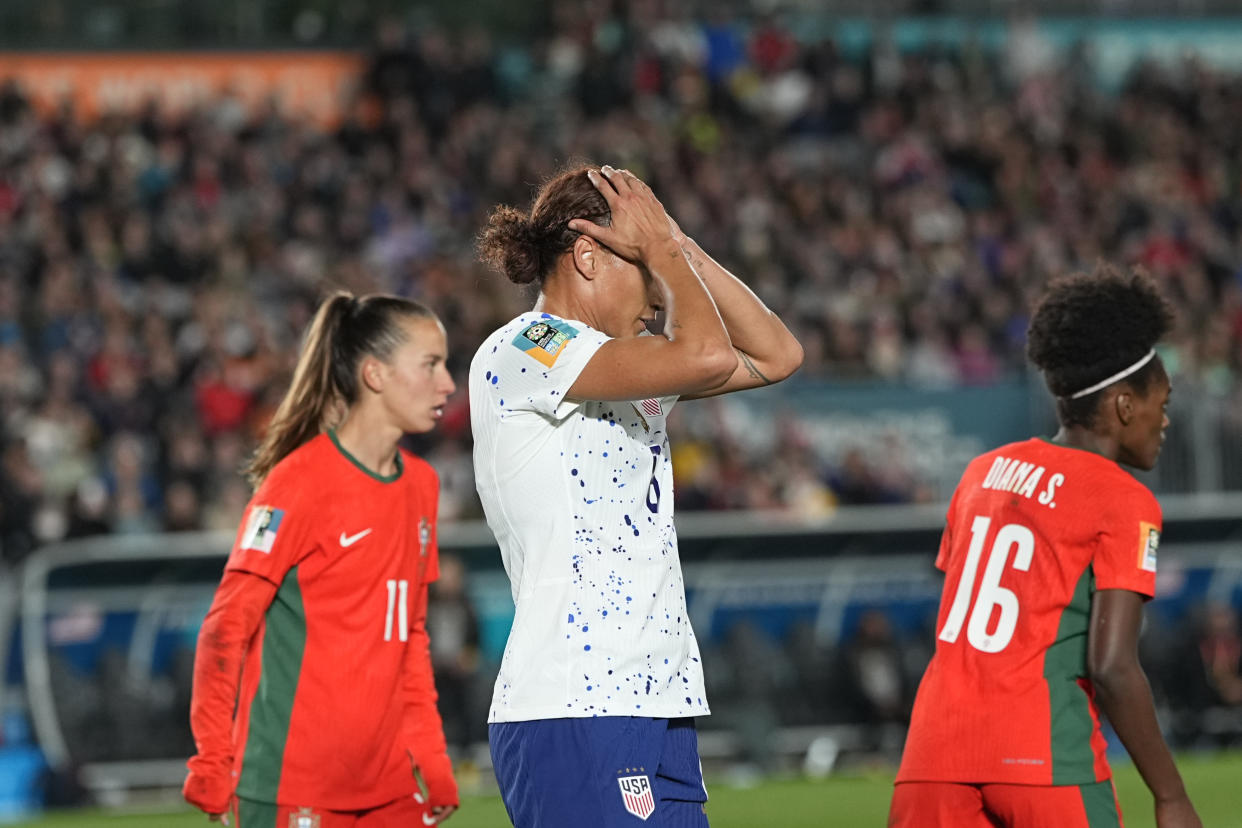USWNT’s group stage dud is a World Cup scheduling nightmare for FIFA, Fox and U.S. viewers
AUCKLAND, New Zealand — The Women’s World Cup schedule had been crafted under an implicit assumption of American dominance. Dozens of FIFA representatives gathered here last October to hash it out. Time zones were tricky, but they hatched a plan to accommodate the United States, their biggest women’s soccer market. They scheduled two U.S. games for 1 p.m. here in New Zealand, which equated to 9 p.m. Eastern Time. Then they went a step further, placing Round of 16 and quarterfinal matches in the Oceania afternoon. The Group E winner, they decided, would play at noon in Sydney, then 1 p.m. in Wellington — smack-dab in U.S. prime time.
Their problem, though, was that they couldn’t guarantee who the Group E winner would be.
And on Tuesday at Eden Park, their fears were realized.
[Join or create a Yahoo Fantasy Football league for free today]
The U.S. laid an egg against Portugal. The Netherlands strolled past Vietnam to the top of the group. So it’s the Dutch who will go to Sydney — for a game that will begin at 10 p.m. ET and 4 a.m. in Amsterdam.
The U.S., meanwhile, will head to Melbourne to play at 7 p.m. local time Sunday — which is 5 a.m. in New York.
The schedule had been optimized for the American audience, and for Fox Sports and Telemundo, FIFA’s U.S. television partners.
But thanks to a flailing U.S. women’s national team, optimization backfired.
How FIFA crafts the Women’s World Cup schedule
The World Cup schedule was finalized over several intense hours immediately after October’s draw. With groups set and locations already decided, FIFA officials of all kinds — from various divisions, including competitions, team services, administration, broadcast, event promotion, partnerships and communications — gathered to sort out kickoff times, and piece together a sprawling puzzle.
“It is a highly complex process which balances travel, player welfare, pitch management, television, and logistics, among other factors,” a FIFA spokesperson told Yahoo Sports in an emailed statement. And while in-stadium audiences are one factor, “it is important to schedule matches at times that support the development and accessibility of the sport globally,” the spokesperson said. “FIFA always attempts to find the best possible balance between making the game accessible to fans in the local market, whilst maximizing global appeal.”
At the men’s World Cup, it sought truly global appeal, with fixed windows for games every day — 1, 4, 7 and 10 p.m. in Qatar.
Here, at the Women’s World Cup, it prioritized the markets of participating teams, game-by-game, growing the sport country-by-country. The U.S., Canada, Argentina and Colombia, for example, all played early-afternoon matches Down Under — and therefore in prime time back home. China and European teams, meanwhile, played late into the Aussie night.

The flexibility came at a cost. The U.S.-Netherlands showdown, tailor-made for the U.S. audience at 9 p.m. ET, began at 3 a.m. in Holland. And it didn’t sell out — probably because it began at 1 p.m. on a Thursday, while locals were working.
But it drew a record-breaking TV audience to Fox and Telemundo. Colombia’s opener against South Korea, at noon on a Tuesday in Sydney, drew over 9 million Colombian viewers at 9 p.m. COT, more than every 2022 men’s World Cup match except for the epic final, according to FIFA. Those benefits, in various ways, outweigh any cost.
Which is why FIFA took a chance on the USWNT topping Group E. After all, the Americans had topped their group at all but one previous Women’s World Cup. If they had again in 2023, they’d have earned two more prime-time games, and two more massive TV audiences.
But they didn’t. And once the schedule is set, there’s no going back.
Why FIFA can’t ‘flex’ World Cup games
There was a thought, among some savvy American viewers who enjoy sleep, that FIFA could “flex” games like the NFL does. In theory, organizers could flip the kickoff times of the two Sunday games in Melbourne and Sydney — to put the USWNT at 10 p.m. ET and the Dutch at 11 a.m. Central European Time.
But such a move has never been considered, according to multiple people with knowledge of the situation. There had been “no discussions” between FIFA and Fox, and there were no “possibilities around flexing kick off times based on results,” one source said. The schedule is “100% locked in.”
Because a World Cup and an NFL Sunday are completely different animals.
The NFL deals with fan bases that mostly live in a home team’s region; FIFA deals with travelers from around the world, some of whom have bought tickets months in advance and booked flights or trains for the morning of a game.
The NFL alters game times a week or weeks in advance; FIFA, at a World Cup, would need to disrupt plans — of fans, and local police departments, and others — on four days’ notice.
And the NFL deals with a small handful of broadcasters; FIFA deals with dozens and dozens, in over a dozen different time zones, all with their own programming schedules and advertising deals and more.
So there is no longer flexibility. There are only middle-of-the-night games to come. (The USWNT’s quarterfinal would kick off at 3:30 a.m. ET.)
FIFA said in its statement that it “recognises the United States of America as a developed and engaged market for women’s football and the FIFA Women’s World Cup. Following the draw in Auckland last year, FIFA recognized some opportunities to schedule two USWNT group matches at times that it believed would be attractive to many stakeholders.” It didn’t directly answer a question about its knockout-round calculus.
